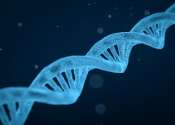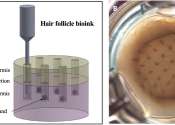Last update:
Biotechnology news

Solving the side effect problem of siRNA drugs for genetic disease treatment
Small interfering RNA (siRNA) drugs are a class of therapeutic agents that silence specific genes associated with inherited diseases. However, siRNA drugs have challenges because siRNAs often silence genes other than the ...
Biotechnology
18 hours ago
0
65

Molecular simulations and supercomputing shed light on energy-saving biomaterials
A team led by scientists at the Department of Energy's Oak Ridge National Laboratory identified and successfully demonstrated a new method to process a plant-based material called nanocellulose that reduced energy needs by ...
Biotechnology
20 hours ago
0
1

Phage editing technology could lead to alternative treatments for antibiotic-resistant bacteria
As antibiotic resistance becomes an increasingly serious threat to our health, the scientific and medical communities are searching for new medicines to fight infections. Researchers at Gladstone Institutes have just moved ...
Cell & Microbiology
Sep 5, 2024
0
36

Researchers develop molecular biosensors that only light up upon binding to their targets
Biosensors—devices that use biological molecules to detect the presence of a target substance—have enormous potential for detecting disease biomarkers, molecules-in-action in diverse biological processes, or toxins and ...
Biotechnology
Sep 5, 2024
0
59

Labs collaborate to enhance imaging tools for cell observation
Two labs at the University of Utah's Department of Chemistry joined forces to improve imaging tools that may soon enable scientists to better observe signaling in functioning cells and other molecular-scale processes central ...
Cell & Microbiology
Sep 5, 2024
0
26

Research team designs efficient bioenergy crops that need less water to grow
Drought stress has long been a limiting factor for crop production around the world, a challenge exacerbated by climate change.
Biotechnology
Sep 5, 2024
0
8

Miniature treadmills accelerate studies of insects walking
Fruit flies walking on miniature treadmills are helping scientists learn how the nervous system enables animals to move in an unpredictable and complex world.
Plants & Animals
Sep 4, 2024
0
85

Satellite remote sensing shows potential in agricultural monitoring
Paddy rice is an important agricultural product, and accurate mapping of paddy rice fields is essential for enhancing food security, promoting sustainable agriculture, increasing crop yields, and facilitating technological ...
Biotechnology
Sep 4, 2024
0
7

Developing bird migration tracking with call detection technology
A research team primarily based at New York University (NYU) has achieved a breakthrough in ornithology and artificial intelligence by developing an end-to-end system to detect and identify the subtle nocturnal calls of migrating ...
Ecology
Sep 4, 2024
0
19

Foamed plastic carriers boost biofilm formation in wastewater treatment
For the sake of the environment and our quality of life, effective treatment of wastewater plays a vital role. A biological method to treat sewage using moving, biofilm-covered plastic items known as carriers has been gaining ...
Cell & Microbiology
Sep 4, 2024
0
1

Novel software tool enables quality control independent of omics molecular types and can be used on multiple platforms
Quality control (QC) strategies for monitoring and assessing instrument performance during mass spectrometry analysis is crucial for ensuring that the data generated is high-quality, reproducible, and accurate.
Biotechnology
Sep 4, 2024
0
27

Scientists uncover diverse marine microbes with potential for new antibiotics and plastic breakdown
New research shows how oceans can be used to help address major challenges such as the shortage of antimicrobial medicines, solutions for plastic pollution and novel enzymes for genome editing.
Cell & Microbiology
Sep 4, 2024
0
7

Computer model boosts detection of cell-to-cell communication
A computer model developed by UT Southwestern Medical Center researchers significantly enhances the ability of scientists to detect communication between cells, according to a new study published in Nature Methods.
Cell & Microbiology
Sep 4, 2024
0
140

Feeder-free induced pluripotent stem cells show promise for chronic kidney disease therapies in cats
Amid advances in medicine to improve people's quality of life, an Osaka Metropolitan University-led team has, for the first time in the world, generated high-quality feline induced pluripotent stem cells (iPSCs), which have ...
Biotechnology
Sep 4, 2024
0
12

Plant e-skin enables continuous, non-invasive monitoring for precision farming
Precision farming is an emerging field that uses analysis tools such as sensors to collect data on crop plant conditions, such as temperature, humidity, moisture, and nutrient levels. The data collected from these sensors ...
Biotechnology
Sep 4, 2024
0
4

New machine learning model offers simple solution to predicting crop yield
A new machine-learning model for predicting crop yield using environmental data and genetic information can be used to develop new, higher-performing crop varieties.
Biotechnology
Sep 3, 2024
0
13

Breaking boundaries: PAM-less genome editing in soybean
CRISPR-Cas9 has transformed crop genetic improvement, yet its reliance on specific protospacer adjacent motif (PAM), sequences limits editing scope and efficiency. In soybean, a critical source of protein and oil, these limitations ...
Biotechnology
Sep 3, 2024
0
1

Biologists warn of potential errors in microRNA overexpression method
The work of a researcher involves not only continuous pursuit of new discoveries but also careful attention to conventional, established knowledge. Sometimes, reliable and seemingly proven methods have characteristics that ...
Biotechnology
Sep 3, 2024
0
43

Enhancing microbe memory to better upcycle excess CO₂
While some microbes can make people sick or spoil food, others are critical for survival. These tiny organisms can also be engineered to make specific molecules. Researchers reporting in ACS Sustainable Chemistry & Engineering ...
Cell & Microbiology
Aug 30, 2024
0
11

Light-activated polymerization methods unlock new possibilities for intracellular applications
Synthetic polymers play a crucial role in cell biology, serving as delivery vehicles for DNA and drugs, acting as fluorescent probes for cellular sensing, functioning as bioinks for tissue engineering, and mimicking biological ...
Cell & Microbiology
Aug 30, 2024
0
20
More news

Bacterial defense strategy has potential application in genome editing

Hybrid imaging approach reveals microbes in 3D

How engineered walnuts combat drought through grafting

The promise of synthetic cells

Coaxing purple bacteria into becoming bioplastic factories

Improving the accuracy of global cropland mapping
Other news

Nearby super-Earth has a sulfur-rich atmosphere, Webb observations suggest

Crystallized alternative DNA structure sheds light on insulin and diabetes

Scientists uncover mechanism preserving centromere during cell division

Solution to a cosmic mystery—the eccentric orbits of trans-Neptunian objects

Why are black holes stable against their own gravity?

Researchers discover an effective and environment-friendly disinfectant

Antibody-like molecule shows promise for broad-spectrum malaria therapy

Researchers create a one-dimensional gas out of light

Mysterious 50-million-year-old fish to get a new genus






















































